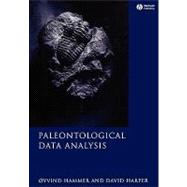
Note: Supplemental materials are not guaranteed with Rental or Used book purchases.
Purchase Benefits
Looking to rent a book? Rent Paleontological Data Analysis [ISBN: 9781405115445] for the semester, quarter, and short term or search our site for other textbooks by Hammer, Øyvind; Harper, David A. T.. Renting a textbook can save you up to 90% from the cost of buying.
David Harper is Professor of Paleontology and Deputy Director of Geology at the Natural History Museum of Denmark, University of Copenhagen. His research interests include the history of biodiversity; fossil brachiopods from the Palaeozoic rocks of NW Europe, North America, and China, and from the Cretaceous and Cenozoic rocks of the Caribbean; computer-based methods for the analysis and modeling of fossils and their distributions.
| Preface | ix | ||||
| Acknowledgments | xi | ||||
|
1 | (7) | |||
|
1 | (3) | |||
|
4 | (3) | |||
|
7 | (1) | |||
|
8 | (53) | |||
|
8 | (4) | |||
|
12 | (7) | |||
|
19 | (3) | |||
|
22 | (1) | |||
|
23 | (4) | |||
|
27 | (3) | |||
|
30 | (3) | |||
|
33 | (2) | |||
|
35 | (4) | |||
|
39 | (3) | |||
|
42 | (4) | |||
|
46 | (2) | |||
|
48 | (5) | |||
|
53 | (4) | |||
|
57 | (4) | |||
|
61 | (17) | |||
|
61 | (1) | |||
|
62 | (1) | |||
|
63 | (3) | |||
|
66 | (1) | |||
|
67 | (8) | |||
|
75 | (3) | |||
|
78 | (79) | |||
|
78 | (1) | |||
|
79 | (4) | |||
|
83 | (8) | |||
|
91 | (5) | |||
|
96 | (4) | |||
|
100 | (3) | |||
|
103 | (2) | |||
|
105 | (3) | |||
|
108 | (4) | |||
|
112 | (3) | |||
|
115 | (2) | |||
|
117 | (4) | |||
|
121 | (1) | |||
|
122 | (6) | |||
|
128 | (4) | |||
|
132 | (2) | |||
|
134 | (2) | |||
|
136 | (5) | |||
|
141 | (4) | |||
|
145 | (12) | |||
|
148 | (9) | |||
|
157 | (26) | |||
|
157 | (3) | |||
|
160 | (1) | |||
|
161 | (5) | |||
|
166 | (2) | |||
|
168 | (1) | |||
|
168 | (2) | |||
|
170 | (1) | |||
|
171 | (1) | |||
|
172 | (2) | |||
|
174 | (1) | |||
|
175 | (3) | |||
|
178 | (5) | |||
|
179 | (4) | |||
|
183 | (71) | |||
|
183 | (3) | |||
|
186 | (7) | |||
|
193 | (3) | |||
|
196 | (2) | |||
|
198 | (4) | |||
|
202 | (4) | |||
|
206 | (2) | |||
|
208 | (3) | |||
|
211 | (5) | |||
|
216 | (5) | |||
|
221 | (2) | |||
|
223 | (10) | |||
|
233 | (3) | |||
|
236 | (4) | |||
|
240 | (14) | |||
|
244 | (10) | |||
|
254 | (25) | |||
|
254 | (1) | |||
|
255 | (5) | |||
|
260 | (3) | |||
|
263 | (3) | |||
|
266 | (3) | |||
|
269 | (2) | |||
|
271 | (8) | |||
|
273 | (6) | |||
|
279 | (38) | |||
|
279 | (2) | |||
|
281 | (2) | |||
|
283 | (3) | |||
|
286 | (5) | |||
|
291 | (7) | |||
|
298 | (8) | |||
|
306 | (8) | |||
|
314 | (1) | |||
|
315 | (2) | |||
| Appendix A: Plotting techniques | 317 | (11) | |||
| Appendix B: Mathematical concepts and notation | 328 | (5) | |||
| References | 333 | (12) | |||
| Index | 345 |
The New copy of this book will include any supplemental materials advertised. Please check the title of the book to determine if it should include any access cards, study guides, lab manuals, CDs, etc.
The Used, Rental and eBook copies of this book are not guaranteed to include any supplemental materials. Typically, only the book itself is included. This is true even if the title states it includes any access cards, study guides, lab manuals, CDs, etc.